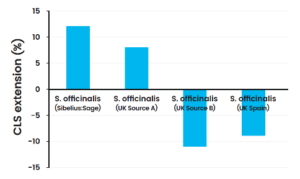In a previous blog, I wrote about the advancements in technology and how these innovations contributed to making our supplements better. However, it is good to note where and how your herbs are grown may impact their effectiveness. When we factor in different growing conditions, soil makeup, annual rainfall, drought, deep freezes, and geography, we will notice that these all play a factor in a plants’ nutritional and phytochemical profile. The following will take a closer look at some great examples of these variations.
Chaga
It would be wise to give a quick recap on the “King of the Medicinal Mushrooms.” Chaga has been revered for its benefits to immune health and function. It has always been one of my favorite suggestions for someone looking for a supplement to support their immune health over long periods. Wild Chaga primarily grows on birch trees in the arctic and sub-arctic forests, where the cold environment contributes to its health benefits.
The part of the Chaga grown in the wild which is harvested is called a conk. The conk is a growth of the Chaga mycelium, and its hard, black outer shell is called the sclerotium. Sclerotium is unique to only wild-crafted Chaga because it grows in the harsh environment of the Arctic. The area inside the conk contains most of the micro chemicals and beta-glucan components typically linked to chaga’s health benefits. Additionally, other powerful antioxidant compounds called polyphenols found the sclerotium, which imparts even more health benefits to this great mushroom. As mentioned in the introduction, where your botanicals are grown matters, and, in this case, there are now chaga ingredients available that are cultivated on grain and not in the wild. Growing chaga this way has a significant impact on the health benefits, as you can see in the chart below.
|
Cultivated chaga grown on grain contains only a fraction of the active compounds and bioactivity compared to wild-grown (on birch trees) chaga extracts |
| Cultivated chaga grown on grain contains significant amounts of starch (because grains are high in starch) |
|
Wild-crafted chaga has a hard outer sclerotium shell that contains a high concentration of polyphenols which provide exceptionally high antioxidative properties. |
|
The nutrition-dense sclerotium is completely missing from all chaga cultivated on grain. |
Buyer Beware:
Many Chaga supplements only list” chaga mycelium” or “myceliated brown rice,” which means that the mushroom is not sourced from wild chaga growing on Birch trees. These types of such mushroom ingredients will not have the same medicinal profile as wild-grown Chaga. Two well-known chaga extracts are available, grown on Larch trees, and provide the full benefits of this potent botanical: Feno-Chaga® and SibeliusTM: MyceliAid.
Sage
While many of us may be familiar with the spice sage for its aroma and flavor in our foods, sage has many positive effects on your health too. Dating back to over 4000 years, Ancient Egyptians believed it helped with infertility.[i] In addition, Sage has a longstanding reputation as traditional herbal remedies used by ancient Greek and Roman, Ayurvedic, Native American, and Chinese folk medicines. For centuries, sage has been used for conditions such as pain relief, as an antioxidant, fight inflammation, hot flashes, gas, bloating, cholesterol, cognitive performance, and memory.[ii] In modern times, sage is used for its proven benefits in cognitive performance, primarily; concentration and focus.
Like with chaga mentioned above, where your sage comes from matters too. Different varieties of sage grown under the same conditions, and even the same variety of sage grown at the same location but harvested at a different time do not provide the same phytochemical or nutritional values when tested. One such ingredient, Sibelius™: Sage extract, is derived from plants grown in Hampshire in the U.K. As a result, the herbal extract has a unique profile when analyzed. Granted, the chart below may be a bit technical, but we can see that SibeliusTM: Sage provides significant benefits over sage grown in other parts of the U.K. and Spain.

Chronological Life Extension (CLS Extension-left side of the chart above) is measured using the patented ChronoscreenTMtechnology and allows for identifying biologically active natural products.
Rhodiola
Rhodiola is another excellent botanical known for its health benefits as an adaptogen. Adaptogens are supplements that help the body adapt to both physical and emotional (mental) stressors. Yes, physical, i.e., strenuous activities, extreme temperatures (hot and cold), and emotional, i.e., stress, sleep disturbances, and other mental health challenges. Rhodiola has been used for centuries, primarily in Siberia and northern China yet Siberia is where the plant was traditionally grown and consumed.
Currently, Rhodiola is used for stress, sleep, sports recovery, and immune support. It is believed that the harsh Siberian environment and the rocky growing environment provide benefits to the plant. The people living in this region used the plant to help their bodies handle the same harsh environment (adaptogen) the plant is grown in. One of my favorite Rhodiola extracts is Rhodiolife® which has science proving its benefits for improving endurance, protecting muscle cells, improving recovery, reducing fatigue, improving memory, and help with stress. Rhodiolife® is grown in Siberia and, like chaga, is wild-crafted, which helps assure sustainability too.
Summary
We can see in these three examples that it is essential to find out where or how your herbs/botanicals are grown. Environmental conditions, geography, growing season, and more all play a role in how effective your supplements can be. As consumers, it is worth taking a little extra time and research to find out where your herbal supplements come from, how they are grown, and are they clinically proven and researched.
[i] Salvia Kornati website, https://salvia.bio/sage-history/ Accessed 9/3/2019
[ii] Natural Medicines Website: https://naturalmedicines.therapeuticresearch.com/databases/food,-herbs-supplements/professional.aspx?productid=504 Last reviewed 8/14/2019, Accessed September 4, 2019

